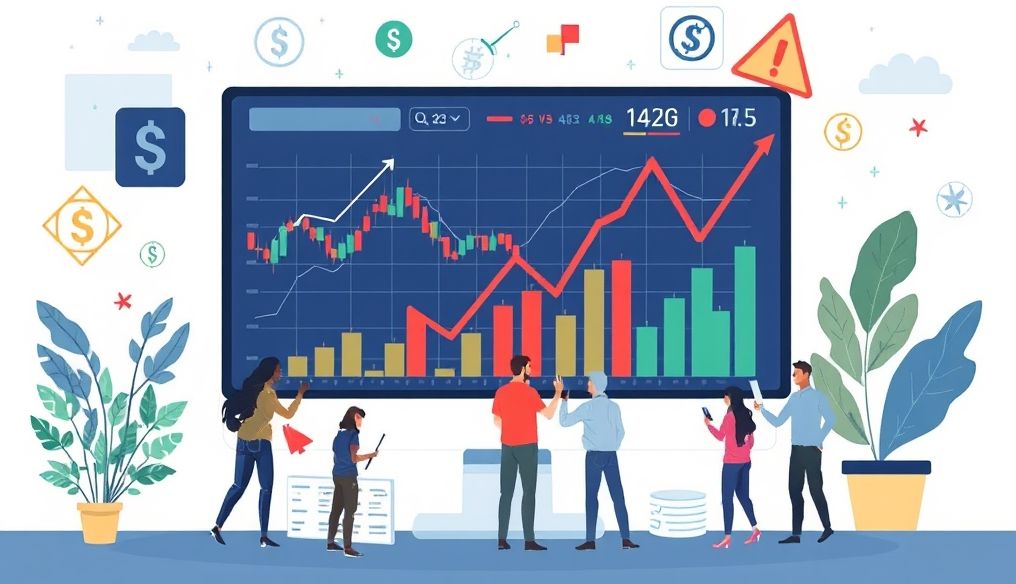Introduction to Forex Trading
The Forex market is the largest financial market in the world, with trillions of dollars traded daily. This market offers immense opportunities for traders to profit, but it also carries significant risks. For beginners, it is essential to understand the basics of Forex and how it works before starting to trade.
What is Forex?
Forex is an abbreviation for "Foreign Exchange," which means exchanging foreign currencies. Currencies are traded in pairs, such as EUR/USD (Euro vs. US Dollar) or GBP/JPY (British Pound vs. Japanese Yen). The value of a currency depends on the supply and demand in the market.
How Does Forex Trading Work?
When trading Forex, you buy one currency and sell another at the same time. If you believe that the value of the Euro will rise against the US Dollar, you will buy the EUR/USD pair. If the Euro's value actually rises, you will profit. If it falls, you will lose.
Fundamentals of Risk Management in Forex
Risk management is the core of success in Forex trading. Without an effective risk management strategy, you are putting your capital at risk. Here are some fundamentals that every beginner trader should know:
1. Determine the Risk Size per Trade
Do not risk more than 1-2% of your capital on any single trade. This golden rule helps you protect your capital from significant losses. For example, if you have a trading account worth $10,000, you should not risk more than $100-200 per trade.
2. Use Stop-Loss Orders
Stop-loss orders are essential tools for managing risk. These orders determine the price at which the trade will be automatically closed if the market moves against you. You should place a stop-loss order for every trade you make.
Example: If you bought EUR/USD at 1.1000, you can place a stop-loss order at 1.0950. This means that if the EUR/USD price falls to 1.0950, the trade will be closed automatically, limiting your losses.
3. Use Take-Profit Orders
Take-profit orders determine the price at which the trade will be automatically closed to secure profit. These orders help you achieve your profit goals and avoid greed.
Example: If you bought EUR/USD at 1.1000, you can place a take-profit order at 1.1050. This means that if the EUR/USD price rises to 1.1050, the trade will be closed automatically, securing your profit.
4. Calculate the Risk-Reward Ratio
The risk-reward ratio measures the potential profit compared to the potential risk. You should aim for a risk-reward ratio of at least 1:2. This means that for every dollar you risk, you should have the opportunity to make at least two dollars in profit.
Example: If you are risking $50 on a trade, you should have the opportunity to make at least $100 in profit.
5. Diversification
Do not put all your money into one trade or one currency pair. Diversification helps you reduce risk by spreading your investments across different assets.
6. Use Leverage Cautiously
Leverage allows you to trade larger amounts than your actual capital. While it can increase your profits, it can also increase your losses. You should use leverage cautiously and only when you understand the risks involved.
Example: If you have a leverage ratio of 1:100, this means that you can trade $100,000 with a capital of only $1,000. However, if you lose the trade, you will incur a significant loss.
Forex Trading Strategies for Beginners
There are many Forex trading strategies that beginners can use. Here are some common strategies:
1. Day Trading
Day trading involves opening and closing trades on the same day. This strategy requires constant monitoring of the market and quick analysis of data.
2. Swing Trading
Swing trading involves holding trades for several days or weeks to profit from market fluctuations. This strategy requires basic technical analysis and trend identification.
3. Long-Term Trading
Long-term trading involves holding trades for several months or years to profit from long-term trends. This strategy requires deep fundamental analysis and an understanding of macroeconomics.
Forex Trading Tools and Resources
There are many tools and resources available to traders in the Forex market. Here are some important tools and resources:
1. Trading Platforms
Trading platforms are the software you use to open and close trades. Some popular trading platforms include MetaTrader 4 (MT4) and MetaTrader 5 (MT5).
2. Charts
Charts display price movements over time. Charts help you analyze trends and identify entry and exit points.
3. Economic News and Analysis
Economic news and analysis provide you with information about economic events that can affect currency prices. You should follow economic news and analysis regularly to make informed trading decisions.
4. Training Courses and Books
There are many training courses and books available that can help you learn more about Forex trading. Invest in your education to increase your chances of success.
Common Mistakes to Avoid in Forex Trading
Many beginner traders make common mistakes that can lead to significant losses. Here are some mistakes to avoid:
1. Emotional Trading
Emotional trading involves making trading decisions based on emotions rather than logical analysis. Avoid emotional trading and try to make rational trading decisions.
2. Lack of a Trading Plan
Without a trading plan, you are trading randomly. You should have a clear trading plan that defines your goals, strategies, and risk management rules.
3. Failure to Learn from Mistakes
Learning from mistakes is an essential part of the trading process. Analyze your losing trades and try to understand the reasons that led to the loss. Use this information to improve your strategies in the future.
Additional Tips for Beginner Traders
- Start with a demo account to practice trading without risking real money.
- Be patient and do not expect to make quick profits.
- Continue to learn and develop your skills.
- Join Forex trading communities to exchange ideas and experiences with other traders.
Conclusion
Forex trading can be profitable, but it also requires knowledge and effort. By following proper risk management strategies and continuous learning, you can increase your chances of success in the Forex market.
Frequently Asked Questions About Forex Trading
1. What is the best time to trade Forex?
The best time to trade Forex is when there is high trading volume and market volatility. London and New York trading sessions are often the most active.
2. What are the best currency pairs to trade?
The best currency pairs to trade depend on your strategy and goals. Some popular currency pairs include EUR/USD, GBP/USD, USD/JPY, and AUD/USD.
3. What is the minimum capital required to start Forex trading?
The minimum capital required to start Forex trading varies from broker to broker. You can start with a small amount like $100 or less, but it is better to start with a larger amount to increase your chances of success.
4. How can I choose a reliable Forex broker?
When choosing a Forex broker, you should make sure that it is licensed and regulated by a reputable regulatory authority. You should also compare the fees and commissions charged by different brokers.
5. Is Forex trading halal or haram?
This question depends on the interpretation of Islamic Sharia. Some scholars believe that Forex trading is halal if certain conditions are met, such as avoiding excessive leverage and avoiding usurious interest. You should consult a religious scholar for a Sharia ruling.
Additional Resources for Learning Forex Trading
- Babypips.com: A comprehensive educational website for Forex trading.
- Investopedia.com: A website that provides information on a wide range of financial topics, including Forex.
- ForexFactory.com: A Forex trading forum where you can exchange ideas and experiences with other traders.




